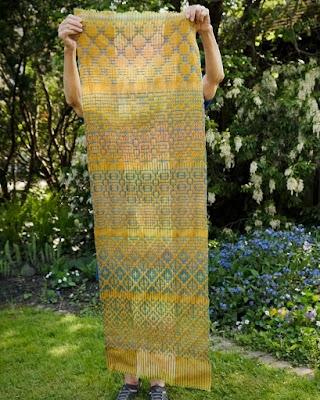Top photo: handwoven cloth in loom state
Bottom photo: detail of cloth after finishing
"Loom state" describes fabric that has not yet been finished or dyed. In the textile industry, such fabric is also called "gray" or "griege."
The finishing process is particularly important to weavers because, as I like to say, "It ain't over till it's finished" (with a nod to Yogi Berra). Woven fabric isn't ready to use until it's properly washed. Unfinished or unwashed, it will retain some of the tension that it was under during the weaving process and thus won't feel or behave optimally.
Differential shrinkage takes the process one step further, creating a puckered or pleated fabric, using warm water, gentle soap and lots of agitation by hand or machine. With this technique, one block or group of yarns (such as the turquoise 18/2 merino in the photos above) will full and shrink while the other (the 10/2 cotton in gold) doesn't, creating lots of texture and visual interest.
Deflected Double Weave works well for differential shrinkage because of the plentiful floats and open spaces that alternate with blocks of plain weave. By definition, it has two layers that weave in and out of each other (but never on top of each other, hence the term "deflected").
When I posted some photos on Facebook -- after fulling to create differential shrinkage -- one weaver thought the fabric was stitched double weave. I explained that it only appeared that way because the layers of wool fuse together and the cotton relaxes, losing the gaps between blocks and appearing as if it were one layer.
Here's what the back of the fabric looks like before finishing -- that is, in loom state. (My apologies for the fuzzy image, but I was using my iPhone in reverse to photograph the underside of the fabric while it was on the loom.)













10 comments:
Oh I love this! I immediately thought that it would make a great Chanel style jacket. I just can't decide which side I like best. But I definitely prefer it after finishing. Sorry, Jake! Thanks for sharing, Denise.
Oh yes! A Chanel jacket would be lovely — if only I had the couture sewing skills....
Amazing - just like magic. Thanks for sharing.
I really really love both the finished and the unfinished cloth, although if it were me doing this type of weaving (and I do want to learn) I would enjoy the unfinished version as an ephemeral pleasure and then finish it every time.
This cloth has a lively presence, and the colors are gorgeous.
You must have a lot of shafts on your loom!
Ruth, this is a 16-shaft pattern, although I'm thinking that it could be adapted to 8 to 12 shafts. Another project! I do teach a Zoom workshop called "Designing with Deflected Double Weave" so, if I'm scheduled to teach it in the future, I will let you know.
Yes please let me know about that class. Also I see you have a pdf class for purchase which I am interested in getting once my current project is off the loom.
Great! We will stay in touch.
Thanks Denise for the interesting blog!It's an amazing result!
I would like to know about any online classes you are planning in Designing with Deflected Double Weave.
I have an 8 shaft 12 treadle Louet Hollandia loom and an 8 shaft Louet Jane70 table loom.
I would love to better understand how to successfully design my own DDW drafts.
I own a copy of Double With a Twist from Marian Stubenitsky but am having problems understanding her notes; perhaps due to the translation.
tbrickerbrac, I will be teaching a workshop on Deflected Double Weave in February through the Reno, NV, weavers guild. If you will contact me at my email address, which is listed on the "Contact" page of this blog, I can give you more information. Thank you for your interest!
Post a Comment